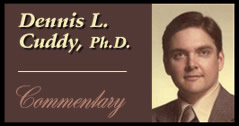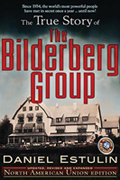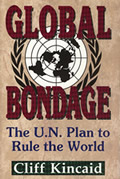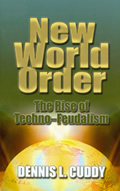A "BOLD NEW WORLD" AND "FORCES TOO POWERFUL"
PART 3
By
Dennis L. Cuddy, Ph.D.
October 31, 2011
NewsWithViews.com
[Note:
To show how the Power Elite’s (PE) plan is coming to fulfillment
today, Rush Limbaugh on his October 21, 2011 radio program said Wall
Street bankers are in the hip pocket of President Obama, and he is in
the hip pocket of Wall Street bankers. This is exactly what Philip Freneau
in American Museum (July 1792) said would happen as part of
a hereditary elite’s (e.g., Rockefellers) plan to gain control
of the U.S. Freneau claimed “money will be put  under
the direction of government, and government under the direction of money.”
The next step in the PE’s plan for world control is a world currency
in 2018 A.D., and you can see a picture of it on the cover of The
Economist for January 9, 1988 right here.
under
the direction of government, and government under the direction of money.”
The next step in the PE’s plan for world control is a world currency
in 2018 A.D., and you can see a picture of it on the cover of The
Economist for January 9, 1988 right here.
Relevant to the PE’s planned economic integration of European nations mentioned in the “Note” of my last two articles in this series, the Financial Times (October 16, 2011) reported that “the eurozone crisis exposed the lack of economic integration needed to complement the European monetary union. But if the 17 partners in the common currency are going to interfere in each other’s fiscal strategies—hitherto regarded as the cornerstone of national sovereignty—then closer political integration is essential, say proponents…. To German eyes, the next step forward in the E.U…. must fill in the gaps… that created a monetary union without fiscal union….”
And relevant to Germany and the secret Nazi plan mentioned in my newest book, For The Record (January 13, 2010) highlighted the relationship between “The Family” (which I have mentioned before) and the Underground Reich as well as the (Martin) Bormann capital network. The following information comes from this FTC radio program. “The Family” was founded in the 1930s by Abram Vereide, and after WWII, it and Vereide got PE agent and American high commissioner John J. McCloy to rescind the de-Nazification program in Germany, which helped Bormann’s network.
Nazi spies Manfred Zapp and Baron Ulrich von Gienanth were close associates of Vereide. In 1938, Zapp came to the U.S. from Pretoria, South Africa (PE member Cecil Rhodes was in South Africa), and he ran the Transocean News Agency (which was really a Nazi espionage and propaganda organization) that afforded him the opportunity to network with those of New York’s elite who were sympathetic to Fascism. Von Gienanth was a Nazi undercover SS diplomat in Washington, D.C., who was watching secret American operations and laundering Reich finance minister Joseph Goebbels’ gold into dollars donated to the America First Committee.
Vereide and “The Family” recruited Nazis to serve U.S. intelligence after WWII. One Nazi Vereide saved was Hermann Abs (known as “Hitler’s Banker”) who would become “Adenauer’s Banker” (Konrad Adenauer was chancellor of West Germany 1949-1963). Abs would also become vice-president of Vereide’s International Christian Leadership.
In my book, The Power Elite and the Secret Nazi Plan, I refer to Curt Riess’s The Nazis Go Underground (1944), which forecast that one of the secret Nazi strategies would involve liaison with American Protestant fundamentalists. In my book, I also refer to Nazi Gen. Reinhard Gehlen, who would become a Christian evangelist when about 70 years of age.]
Like John Clausen’s statement in Part 2 of this series, former OWI overseas director Edward Barrett (head of the U.S. government’s overt psychological warfare program 1950-1952, and later Dean of the Columbia University Graduate School of Journalism) in Truth Is Our Weapon (1953) wrote: “Among OWI alumni are the publishers of Time, Look, Fortune, and several dailies; editors of such magazines as Holiday, Coronet, Parade, and the Saturday Review, editors of the Denver Post, New Orleans Times-Picayune, and others; the heads of Viking press, Harper & Brothers, and Farrar, Straus and Young… the board chairman of CBS and a dozen key network executives… the editor of Reader’s Digest international editions….”
Christopher Simpson in Science of Coercion reveals that “U.S. psychological warfare programs between 1945 and 1960 provide a case study of how the priorities and values of powerful social groups can be transformed into the ‘received knowledge’ of the scientific community and, to a certain extent, of society as a whole… the engineering of consent of targeted populations at home and abroad…. Various leaders in the social sciences engaged one another in tacit alliances to promote their particular interpretations of society…. They regarded mass communication as a tool for social management and as a weapon in social conflict…. Key academic journals of the day… concentrated on how modern technology could be used by elites to manage social change, extract political concessions, or win purchasing decisions from targeted audiences…. This orientation reduced the extraordinarily complex, inherently communal process of communication to simple models based on the dynamics of transmission of persuasive—and, in the final analysis, coercive—messages.” Since that time, commercial advertisers have increasingly used psychological techniques of persuasion upon the American public, and Simpson notes: “From the advertisers’ point of view, the simple sale of products and services is not enough. Their commercial success in a mass market depends to an important degree on their ability to substitute their values and worldview for those previously held by their audience…. Terms like ‘Pepsi Generation,’ ‘Heartbeat of America,’ and ‘I Love What You Do for Me’ have always been more than simple advertisement slogans. They have been successful from the advertisers’ point of view only to the extent they have defined a way of life.”
Concerning the subject of education, as American education continued to decline through the 1970s and 1980s, corporations became increasingly concerned that they would not have enough skilled workers to compete in what they saw as the new “global economy.” Management of “human resources” or “human capital” to compete in such an economy became of prime importance to industry.
On May 8, 1996, A.D., a co-worker of Dr. Shirley McCune at the federally-funded Mid-Continent Regional Educational Laboratory (McREL) told me that McCune (who left McREL around 1994) had referred to work done at the Research Center for Group Dynamics, founded in 1946 by Kurt Lewin. The co-worker said he believed that McCune had known Lewin and had done work for the National Training Laboratories (NTL). Prior to coming to McREL, McCune had been a director of the tax-funded Education Commission of the States (ECS) and had been with the (John) Naisbitt (author of Megatrends) Group. After coming to McREL, McCune authored a 63-page working paper in 1983, for the Kansas State Department of Education, titled “Framing A Future for Education.”
The working paper was largely based upon the views expressed in Megatrends, and McCune stated: “Schools must become more effective and more efficient in providing society with human resources which are essential for our national well-being.” She continued to say that students will be expected to develop “ability to work in groups, use skills in critical thinking, problem solving… synthesizing, decision making and communication—key factors for successful participation in the work force.” Students would be the products or “human capital” for society’s economic system, and there would be “lifelong learning” with an increase in adult education and retraining. McCune went on to say, “The future of all institutions and our total society rests on our ability to develop human capital or to ‘grow better people.’”
Under “Probable Directions for Restructuring Education,” she listed among the “Goals of Education” in “An Information Society” the following: “Global education, small group skills, computer as learning tool in all programs, and career/vocational education as integral pat of educational community experience.” Also under “Probable Directions” in “An Information Society,” she included “School-based management, managed change, economic development (forming human capital), expended support for total population services, business as participant and learning resource, school as community center for varies ages and services, lifelong learning oriented.”
| Subscribe to the NewsWithViews Daily News Alerts! |
On November 2, 1989 McCune spoke at the Kansas Governor’s conference on education, stating that “The Governors began to understand the very close relationship between economic development and human capital…. What we’re into is the total restructuring of the society…. What I’m not sure that we have begun to comprehend or to act on sufficiently is the incredible amount of… human resource development restructuring…. In this particular changed society, there are only two things that really matter… and secondly to produce human capital…. The great majority of businessmen today understand the critical importance of human resource development…. More and more the school is the cob or the center of all human resource development services…. We have to have adults who can be leaders, leaders who can, in fact, have visions of where we can go in the future…. We have to prepare students for the range of knowledge and skills they’ll need… with group and organizational skills… conflict resolution skills…. We’re going to have to provide them with career development skills…. One of the developments that’s going on in more and more communities in this nation… [is] an educator whose job is to work with the social welfare community and put together a total network of human resource development activities in that community where we can actually provide for all of the needs of the children and of the adults in that community…. The earlier we intervene into the lives of people, the cheaper it is.”
� 2011 Dennis Cuddy - All Rights Reserved











 Share
This Article
Share
This Article






